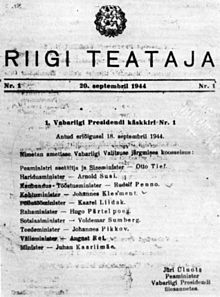Resistance Fighting Day (Estonian: Vastupanuvõitluse päev) also known as Otto Tief Government Day (Estonian: Otto Tiefi valitsuse päev) is a public holiday in Estonia which takes on 22 September.[1][2] It honors the Estonian commander Otto Tief's attempt to restore Estonian independence in 1944. The holiday is a date of remembrance, commemorating the victims of the subsequent re-establishment of Soviet rule in Estonia following the Nazi rule, and the resulting sovietisation of the republic from 1944 to 1950. It falls under the cultural symbols designed to recognize the Occupation of the Baltic states until 1991. It was known in the former Estonian SSR, as well as today by the Russian Federation and pro-Russian forces in Estonia as the Day of the Liberation of Tallinn from Nazi Invaders (Russian: День освобождения Таллина от немецко-фашистских захватчиков), celebrating the Soviet Tallinn Offensive by the Red Army's 2nd Shock and 8th Armies and the Baltic Fleet against the Wehrmacht.

Observances
editThe proposal to mark 22 September as a national holiday was launched in 2005 by the Pro Patria Union and the Res Publica Party[3] The holiday was renamed from Day of the Resistance to Resistance Fighting Day by order of the Riigikogu on 15 February 2007.[4][5] The day was first officially celebrated that year. The main ceremony is held at the Freedom Square in the capital city of Tallinn.[6] Official solemnities begin at sunrise when students from a local school raise the flag of Estonia at the Pikk Hermann.[7] On Resistance Day, the Vabamu Museum of Occupations and Freedom opened an exhibit about the meeting of exiled Estonians and Soviet Estonians. during the Expo 67 in Montreal.[8] The museum is open for free on the holiday.[9]
Soviet "Liberation Day"
editVeterans of the 8th Estonian Rifle Corps often lead solemn ceremonies in the capital. On the third anniversary in 1947, the Bronze Soldier of Tallinn was created.[10] In 2019, the Ministry of Foreign Affairs rebutted claims by Russian foreign ministry spokesperson Maria Zakharova that the Tallinn Offensive was a liberation, saying that it was a false presentation of the "liberation of European peoples from fascist enslavement".[11] That year, a fireworks celebration marking the 75th anniversary of the offensive took place in Moscow.[12]
See also
editReferences
edit- ^ "Resistance Day - 22. September | Government of the Republic of Estonia". www.valitsus.ee. Archived from the original on 2020-06-18.
- ^ "Resistance Fighting Day (Estonia)". ENRS.
- ^ "Valitsus ei toetanud pühade ja tähtpäevade seaduse muutmist. Valitsuse kommunikatsioonibüroo, 22.12.2005". Archived from the original on 2014-04-07. Retrieved 2020-06-18.
- ^ Diener, Alexander C.; Hagen, Joshua (April 14, 2016). From Socialist to Post-Socialist Cities: Cultural Politics of Architecture, Urban Planning, and Identity in Eurasia. Routledge. ISBN 9781317585879 – via Google Books.
- ^ X RIIGIKOGU STENOGRAMM. VI ISTUNGJÄRK. Teisipäev, 15. november 2005. Urmas Reinsalu selgitus.
- ^ "Resistance Fighting Day In Estonia / September 22, 2020". AnydayGuide.
- ^ ERR, ERR (September 23, 2019). "Gallery: Resistance day marked across Estonia". ERR.
- ^ "Estonia commemorates the day the Soviet Union occupied the country". 22 September 2019.
- ^ "Free admission to Vabamu on Resistance Day Estonian Life". Estonian World Review.
- ^ "22 сентября — День освобождения Таллина от немецко-фашистских захватчиков". Baltnews. September 22, 2016. Archived from the original on June 18, 2020. Retrieved June 18, 2020.
- ^ "Foreign ministry rejects Russia's claims of Red Army liberation". ERR. September 23, 2019.
- ^ В Москве артиллерийским салютом отметят 75-летие освобождения Таллина от немецко-фашистских захватчиков mil.ru (in Russian) 19 September 2019